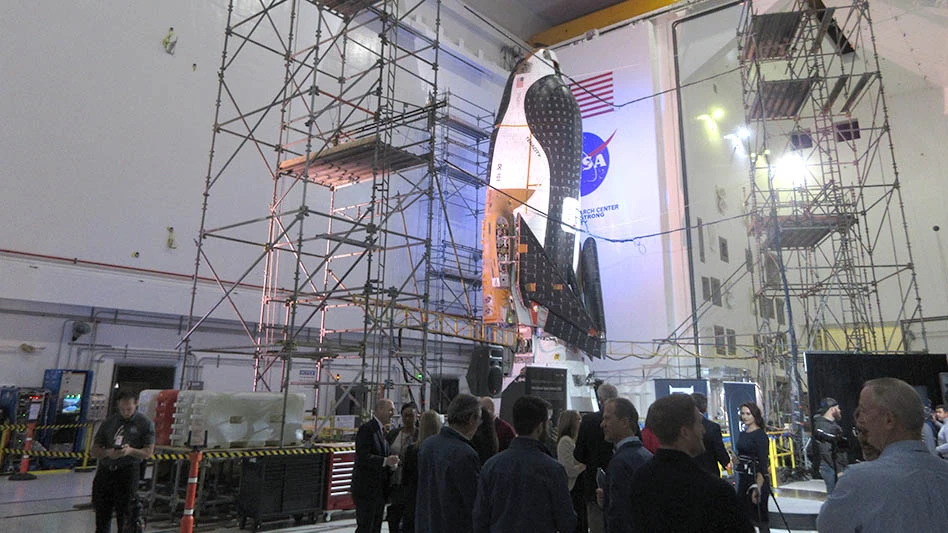
Photo by the author.
As part of NASA's efforts to expand commercial resupply in low Earth orbit, Sierra Space’s uncrewed commercial spaceplane is undergoing testing ahead of its first demonstration flight to the International Space Station (ISS), planned to occur during the first half of 2024.
For the first time, the Dream Chaser spaceplane is being coupled with its companion Shooting Star cargo module in a 55ft-tall vertical stack for environmental testing in the Mechanical Vibration Facility at NASA’s Neil Armstrong Space Environments Complex in Sandusky, Ohio.
Dream Chaser and its cargo module are mounted on NASA’s spacecraft shaker table, exposing the stack to vibrations like those it will experience during launch atop a United Launch Alliance (ULA) Vulcan Centaur rocket and re-entry to the Earth’s atmosphere.
Once vibration testing is complete, Dream Chaser will be moved to the nearby propulsion facility for thermal vacuum testing.
Administratively part of NASA Glenn Research Center in Cleveland, Ohio, the Armstrong Test Facility – located on 6,400 acres – is home to some of the world’s largest and most capable space simulation test facilities, where ground tests are conducted for the U.S. and international space and aeronautics communities.
In 2016, NASA awarded a Commercial Resupply Services-2 contract to Sierra Nevada Corp. (now Sierra Space) to resupply the ISS with its Dream Chaser spaceplane and companion Shooting Star cargo module. NASA’s goal is opening access to space to more science by enabling commercial resupply missions to the ISS, transitioning low Earth orbit to industry while the agency focuses on returning to the moon and eventually Mars as part of Artemis.
Recently, officials spoke about the agency’s efforts to enable the commercial space industry, the unique capabilities of the NASA test facility, and shared more about Dream Chaser and its ongoing testing.
Dr. Jimmy Kenyon, director, NASA’s Glenn Research Center, said, “The Commercial Resupply Services contract … serves as another example of how NASA is working with the commercial industry to open up new opportunities to give access to more people, more science, and more commercial opportunities.”


Tenacity showing its wings folded
and instrumented for vibration
testing. Some thermal tiles (black)
and thermal shielding (white)
have been removed to facilitate
testing, revealing the orange-
colored base skin. Conical
Shooting Star cargo module
is visible below.
Kenyon previously served as director of the Advanced Air Vehicles Program in the Aeronautics Research Mission Directorate (ARMD) at NASA HQ, and prior to that, worked for Pratt & Whitney and as a civilian in the Department of Defense. “We’re very proud of the work we’re doing here with Sierra Space, we’re proud of the work we’re doing to support the private industry developing launch and spaceflight capabilities, and we’re proud to be supporting the International Space Station program.”
Tom Vice, chief executive officer, Sierra Space, and former president of Northrop Grumman’s Aerospace Systems business, added “The most significant industrial revolution in history is underway in space. The orbital age is the next industrial revolution, driven by the underlying technologies commercializing low Earth orbit. Existing companies in every segment of biotech and other industrial sectors will operate the factories of the future in microgravity, extending our cities and communities into space.”
Dream Chaser is designed to be reused up to 15 times. Although the first example, DC-101, named Tenacity, is configured as a cargo carrier, it’s also equipped with an environmental system, allowing a wider range of biologic and other thermally sensitive or delicate cargo.
For the seven commercial resupply missions, the spaceplane and cargo module will carry up to 11,500 lb of supplies to the ISS. Once docked, crew aboard ISS can access the Dream Chaser’s interior and cargo via the Shooting Star. On return to Earth, Dream Chaser can carry more than 3,500 lb of cargo and experiment samples to a 1.5g runway landing, while more than 8,700 lb of trash can be disposed of in the expendable cargo module during reentry.
Future versions of the Dream Chaser will feature a functioning cockpit and crew accommodations, and Dr. Tom Marshburn, former NASA astronaut and chief medical officer for Sierra Space, leads the company’s human spaceflight center and astronaut training academy to be ready.
Latest from Aerospace Manufacturing and Design
- Qatar Airways to buy 400+ GE Aerospace GE9X and GEnx engines
- Electro-mechanical actuator (EMA) subsystem
- Qatar Airways orders up to 210 Boeing widebody jets
- Digital test indicator offers larger measuring ranges
- AviLease orders up to 30 Boeing 737 MAX jets
- 256-piece general maintenance tool kit
- JetZero all-wing airplane demonstrator achieves milestones
- Cermet indexable inserts for medium turning operations





